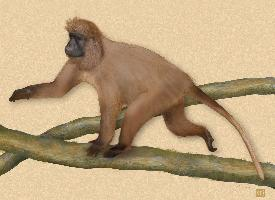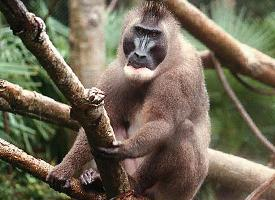
Súlyok és méretek
| Hossz | 76 cm |
|---|---|
| Súly | 10-tól 30-ig kg |
Biológiai adatok
| Élettartam | 25-tól 37-ig éves |
|---|---|
| Vemhességi idő | 190 d |
| Utódok száma | 1 |
Állatleírás
The Hamadryas baboon (Papio hamadryas) is a fascinating and distinctive primate species, belonging to the Old World monkey family. Native to the Horn of Africa and the southwestern tip of the Arabian Peninsula, this species thrives in semi-arid areas, rocky terrains, and savannahs, displaying remarkable adaptability to various environmental conditions.One of the most striking features of the Hamadryas baboon is its physical appearance. Males are considerably larger than females, often weighing between 20 to 30 kilograms, whereas females typically weigh around 10 to 15 kilograms. The males boast an impressive silver-white mantle of fur that drapes over their shoulders and back, giving them a majestic appearance. This mantle contrasts sharply with the males' bright red or pink face and rump, adding to their distinctive look. Females and juveniles, on the other hand, have a more subdued coloration, with shorter, brown fur and less vivid facial and rump coloration.
Hamadryas baboons exhibit a complex and hierarchical social structure known as a multi-level society. Their social organization is based on a system of one-male units (OMUs), where a dominant male leads a group of females and their offspring. Several of these units may come together to form clans, which in turn can aggregate into bands. At the highest level, multiple bands may come together to form a troop, sometimes numbering in the hundreds. This intricate social structure is critical for their survival, providing protection against predators and aiding in the search for food and water.
The diet of the Hamadryas baboon is omnivorous, consisting of a variety of plants, fruits, seeds, and occasionally small animals, insects, and reptiles. Their foraging behavior is highly adaptable, allowing them to exploit a wide range of food resources available in their habitat.
Reproduction in Hamadryas baboons involves complex social interactions and mating rituals. The dominant male of an OMU has exclusive mating rights with the females in his unit, although sneak copulations by subordinate males do occur. Females give birth to a single offspring after a gestation period of approximately six months. The strong social bonds within the OMU are crucial for the protection and rearing of the young.
Conservation status of the Hamadryas baboon is currently listed as "Least Concern" by the International Union for Conservation of Nature (IUCN), indicating that they are not currently at significant risk of extinction in the wild. However, they do face threats from habitat loss, human-wildlife conflict, and hunting in certain areas. Conservation efforts are focused on habitat preservation and mitigating conflicts with human populations to ensure the long-term survival of this unique species.
In summary, the Hamadryas baboon is a remarkable primate with a complex social structure, distinctive physical characteristics, and a wide-ranging diet. Its adaptability to diverse habitats and intricate social behaviors make it a subject of great interest in both scientific research and conservation efforts.
Hasonló állatok
Új állatfotók
Top 10 állat
- Dolphin gull (Leucophaeus scoresbii)
- Diana monkey (Cercopithecus diana)
- Moustached guenon (Cercopithecus cephus)
- Galápagos tortoise (Geochelone nigra complex)
- Japanese macaque (Macaca fuscata)
- Stone loach (Barbatula barbatula)
- Russian tortoise (Testudo horsfieldii)
- Greek tortoise (Testudo graeca)
- Common flying dragon (Draco volans)
- Vendace (Coregonus albula)


